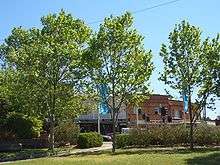Bexley North, New South Wales
| Bexley North Sydney, New South Wales | |||||||||||||||
|---|---|---|---|---|---|---|---|---|---|---|---|---|---|---|---|
|
Shaw Street | |||||||||||||||
 Bexley North | |||||||||||||||
| Coordinates | 33°56′30″S 151°6′41″E / 33.94167°S 151.11139°ECoordinates: 33°56′30″S 151°6′41″E / 33.94167°S 151.11139°E | ||||||||||||||
| Population | 3,999 (2011 census)[1] | ||||||||||||||
| Postcode(s) | 2207 | ||||||||||||||
| Location | 13 km (8 mi) south of Sydney CBD | ||||||||||||||
| LGA(s) | Bayside Council | ||||||||||||||
| State electorate(s) | |||||||||||||||
| Federal Division(s) | Barton | ||||||||||||||
| |||||||||||||||

Bexley North is a suburb in southern Sydney, in the state of New South Wales, Australia 13 kilometres south of the Sydney central business district. It is part of the St George area. Bexley North is in the local government area of the Bayside Council.
History
James Chandler named Bexley after his birthplace in London (formerly Kent), England. Chandler bought Sylvester’s Farm in 1822, from Thomas Sylvester who had been granted the land about ten years earlier. That year he was also granted 1,200 acres (4.9 km2) of land which stretched from what is now Bexley North to most of Rockdale and Kogarah. Development in the area began in 1884 with the railway line to Hurstville.
The opening of the East Hills line and the railway station at Bexley North in 1931, opened up the area for home sites.[2]
Commercial area
Bexley North is mostly a residential suburb with a small shopping centre located around the intersection of Bexley Road with Slade Road and Shaw Street, close to Bexley North railway station. It features a Flemings supermarket, a pub, specialty shops including a prominently placed funeral parlour, cafes and restaurants.
Transport
Bexley North railway station is on the Airport, Inner West & South Line of the Sydney Trains network. Bexley North is also serviced by State Transit Authority bus routes and private bus routes.
The M5 South Western Motorway runs south-west towards Beverly Hills and Liverpool. There are no entrances at Bexley North to the 4 km tunnel which begins here and heads north-east towards Botany and the city. Access to the north east of the motorway is allowed at Kingsgrove and Arncliffe.
Landmarks
- Bardwell Creek and the Prime Minister's Walk to Bexley Pool
- Bexley North Hotel
- Bexley North Library
- Bexley North Public School
- Bexley North Scout Hall
- Holy Trinity Anglican Church
- Stotts Reserve
Population
Demographics
According to the 2011 census of Population, there were 3,999 people usually resident in Bexley North. 56.4% of people were born in Australia. The most common other countries of birth were Greece 6.2%, China 5.9%, Lebanon 2.5%, New Zealand 1.9% and Hong Kong 1.9%. 41.6% of people only spoke English at home. Other languages spoken at home included Greek 17.7%, Cantonese 6.8%, Arabic 6.4%, Mandarin 4.6% and Italian 2.2%. The most common responses for religion in Bexley North were Catholic 23.7%, Eastern Orthodox 23.6%, No Religion 13.1%, Anglican 7.3% and Islam 6.1%.[1]
Notable residents
- Bob Windle, gold medallist in the Men's 1500m Swimming Freestyle at the 1964 Summer Olympics, grew up in the suburb.
- Tim Cahill, Australian footballer, playing for the Socceroos and Everton was a student at Bexley North Primary School.[3]
References
- 1 2 Australian Bureau of Statistics (31 October 2012). "Bexley North (State Suburb)". 2011 Census QuickStats. Retrieved 13 October 2013.

- ↑ The Book of Sydney Suburbs, Compiled by Frances Pollon, Angus & Robertson Publishers, 1990, Published in Australia ISBN 0-207-14495-8, page 28
- ↑ "Cahill mobbed at old school". The Sydney Morning Herald. 2006-07-04. Retrieved 2008-02-24.